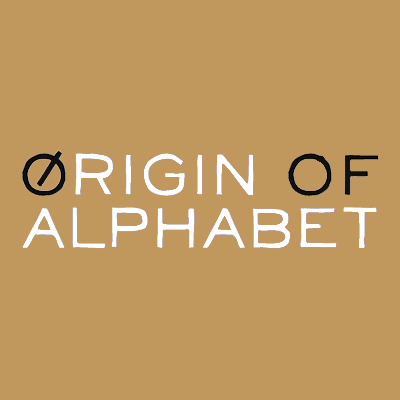Breasts, Vaginas, and Tools: Musings on the roots of our alphabet
If you want to describe something to someone, but neither of you speak the same language, drawing a picture is the simplest way to get your point across. A picture is worth a thousand words because it can propagate information without using the conventions of spoken or written language. Visual communication does not require human-human interaction. Anyone can draw a picture. Anyone else can look at it. If the sender and receiver share enough traits: BINGO! Transmission accomplished. This transmission can be accomplished because homo sapiens share many traits. Humans have been genetically similar for at least a couple hundred thousand years. Consequently, we want the same basic things. These base requirements are reflected in the shapes and sounds of our letters. Our alphabet is a hierarchy of early human needs.
Literacy was driven by the domestication of animals because ownership requires documentation. Domesticating animals also allowed humans to see cause and effect, especially due to the fact that gestation is so much shorter in animals, so humans could more quickly understand the relationship between father and offspring. Noah’s Ark is the world’s first sex education—2 by 2, male and female—but it’s flawed and plagiarized. The first evidence in story form that humans understood the relationship between sex and birth is in the Epic of Gilgamesh, which is 2,500 years older than the Bible. Found in Sumerian cuneiform, as well as in the languages of neighboring Mesopotamian cultures, the Epic of Gilgamesh is a tale focused upon the eventuality of death. Early in the story there is a catastrophe, and the point is made that one must save one’s animals or else one won’t get new animals. Forty thousand years ago in Australia it would seem that the newcomers didn’t understand this. They—or something—wiped out all the megafauna in a short period of time. In domesticating animals, you learn about the facts of life. If you kill them, you only learn about starvation.
When domesticating animals, one learns the importance of females, especially female mammals. Female mammals are important because they have the trinity: milk, offspring, fun for males. Females are the carriers. Brides breed. In fact harems and farms are both types of breeding prisons: one stud male, many females. A dynasty is a “gynasty.” A country is a “cunt-ry”: we forget that we count by “cunts” (my apologies for the word, but if we want to understand language, no word can be off limits, plus every time we say “country” we say a bad word, but we just don’t perceive it that way). The evidence is abundant. A pregnant female is the rate-limiting step toward creating a civilization, so crafty conquerors had lots of non-consensual sex. Genghis Khan has 16 million descendents living today, and he did not ask all those mothers-to-be for consent because consent is a new idea.
The original alphabet went “A, B, V, G…” You can still see this pattern in Cyrillic, which is the script used to write Russian, and also in Ancient Hebrew where בּ “bet” and ב “vet” together represent the second character: which, with a dagesh or dot, has the sound of /b/; without a dot, this character has the sound of /v/. “B” and “V” have a very close association in the alphabet in languages such as Spanish, Hebrew, Russian, Latin, English, as well as logographic languages like Chinese, and the shapes of “B” and “V” have a relationship found on the bodies of female mammals. “B” and “V” together represent the genitalia of female mammals: breasts and vaginas portrayed symbolically.
It is universally agreed that men wrote language. Less recognized is that men wrote language while women were busy dying in childbirth because childbirth is deadly. All literate cultures focus on fertility because that is how the species survives. Statistically men are driven by sex because they don’t die from it like women do, and those who were not driven by sex are no longer in the gene pool. However, men need women as a vehicle for their progeny, and hence the need for more record keeping. Consider that even now, the first thing anyone learns about a woman when hearing her name is her sexual status—via this honorific which is not an honor: “Miss” (virgin) and “Mrs.” (non-virgin). Unless one uses “Ms.”—which, like “Mr.,” does not reveal one’s marital status, and therefore one’s implied sexual status—a woman reveals her “availability” with the addition of “Miss” or “Mrs.” to her name every time it is spoken or written. Men have been keeping track of females for eons, and especially their marital and virginal state because building a society requires the bodies of women; building a civilization requires the bodies of female mammals.
The capital letter “B” in the Roman alphabet has two rounded shapes, resembling both a female mammal’s breasts or teats, as well as a pregnant woman’s body because those double-lobed shapes are congruous—and they represent fertility. The Chinese character for “milk” 奶 similarly includes two semi-round shapes, as does the Chinese character for “pregnant” 孕, which also has “child” 子 emerging from the bottom of the pregnant woman’s representative body. This can be seen in the precursors here: 孕 , also here: 孕. The Egyptian hieroglyph for “milk” is made of four glyphs, two of which are semicircles resembling our capital letter “D” rotated 90 degrees counter-clockwise (here they have been rotated back to facilitate comparison); together, they too, resemble a breasts/teats and a pregnant woman’s body. The Thai word for “mother” แม่ includes four characters, the first two of which resemble the Roman lowercase “b”; placed next to one another, they resemble a woman’s breasts. Finally, the Sumerian character for “child” has a double-breasted appearance which is no surprise as children must suckle milk from their mother’s breasts. Successful cultures are driven by fertility, and writing retains the reasons for their success: buried in language are subliminal depictions of fecundity.
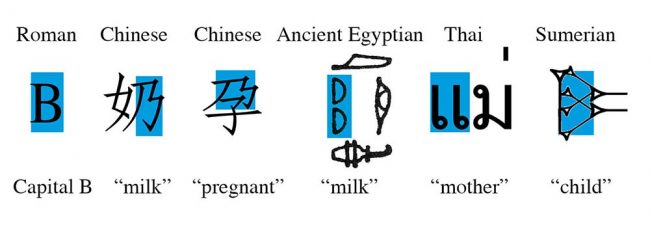
The Chinese-English dictionary defines 奶 as “milk, woman’s breasts, nurse” but this character can also have the meaning of “mistress”: “二奶” or literally “second breast.” How is it that these two—“B” and “乃”—are almost identical, yet most Chinese can acknowledge the resemblance to women’s breasts and most English speakers cannot? The Chinese “B” shape means “breasts,” so logically the Western letter “B” must signify for “breasts” as well, but our culture has been ruled by puritanical thinking. The relationship of “B” to breasts becomes clearer after analyzing enough words that have “B” in them. No coincidence that “baby,” “babe,” “bob,” “boob,” “bib,” “bubble,” “bobble,” “breast,” “bosom,” “bust,” “buxom,” “booty” and “bouncy” start with “B.” Where you find babies, you find milk. Where you find milk, you find mothers. All of these concepts involve full breasts. Large breasts are so desirable in our society that women pay money to have perfectly nice ones cut open just to make them larger. This is because eons of hungry primates sought out milk, and larger breasts appear to hold more volume than smaller ones. Our cultural attraction to large breasts is really a capacity issue. Large breasts = food. The key to our successful survival is buried in written language,
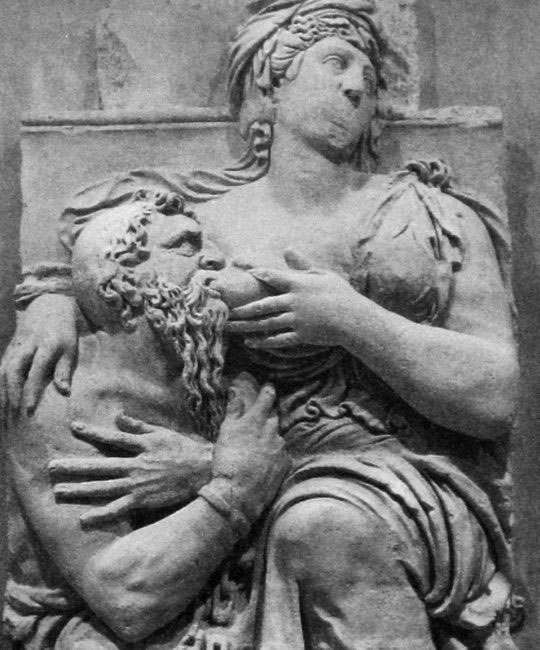 If you think cleavage is important now, imagine if you were thirsty in a time of uncertain water resources. Camels in deserts make a lot of sense. They store fat in their humps, water in their bloodstream. Nature chose another double-humped mechanism for storage. In Hebrew, the word for “camel”and the word for “mother” (specifically “one who weans a child”) is written nearly identically: גָּמַל and גָּמָל; long ago the vowels were not marked, so the words were written the same and only pronounced differently. Human mother and camels were both owed recompense, which is nice but also chilling to recognize they were considered equivalent. “Jenny” is the name for a “mule.” In Chinese “mother” and “horse” are only two tones apart, and they are both beasts of burden. “Mare” and “nag” also have female and horse associations. And then there’s also “she” and “sheep.” “Ewe,” and “you” (significant other) and “U” (symbol for uterus/vagina). “Gangnam Style” is a song that mimes horseback riding but is really about sex. (“Sexy lady,” is a repeated lyric.)
If you think cleavage is important now, imagine if you were thirsty in a time of uncertain water resources. Camels in deserts make a lot of sense. They store fat in their humps, water in their bloodstream. Nature chose another double-humped mechanism for storage. In Hebrew, the word for “camel”and the word for “mother” (specifically “one who weans a child”) is written nearly identically: גָּמַל and גָּמָל; long ago the vowels were not marked, so the words were written the same and only pronounced differently. Human mother and camels were both owed recompense, which is nice but also chilling to recognize they were considered equivalent. “Jenny” is the name for a “mule.” In Chinese “mother” and “horse” are only two tones apart, and they are both beasts of burden. “Mare” and “nag” also have female and horse associations. And then there’s also “she” and “sheep.” “Ewe,” and “you” (significant other) and “U” (symbol for uterus/vagina). “Gangnam Style” is a song that mimes horseback riding but is really about sex. (“Sexy lady,” is a repeated lyric.)
Men, in their “Manifest Destiny” mindset, conflated women with other female mammals because it was convenient and served them well. No surprise Jesus was allegedly born in a manager because that’s where pregnant women were normally kept. The “Red Tent” mentality of secluding and excluding women was a universal concept since fertile women are historically nearly always pregnant (unless they are nuns), only menstruating when they are nursing. Women lose their fertility around 45-55, and enter menopause. Due to this, literate cultures demean older women, calling them witches, hags, and crones. “Old wives tales” implies “sketchy info.” Even grandmothers are suspect because we all know there’s a possibility “she” might actually be a wolf in Grandmother’s clothing, so negatively have all adult women been portrayed by male authors and storytellers.
Consequently, women and milk are much maligned in language:
“You’re milking that theory!”
“You suck!”
Why is sucking bad if we all sucked? Why would “milking” something be an insult? Because men wrote language. They haven’t yet worked out their jealousy about women’s abilities.
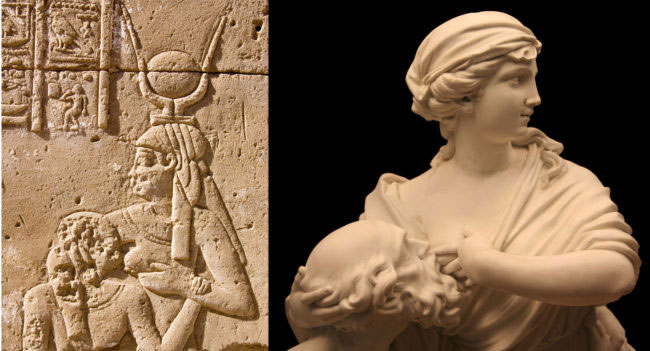
Porn, nursing, nor art has changed in circa 3,000 years. Above, left: “Stone hieroglyphic carving of the Ancient Egyptian Goddess Hathor nursing the Pharaoh.” There are many such depictions because this particular close relationship was deemed evidence of the right to rule. At right, a marble sculpture depicts the popular “Roman Charity,” a story about a woman who secretly breastfed her imprisoned father so that he would not die condemned to starvation. This story is also found in China, where it appears to be older, and involves the mother-in-law instead of the father.
To be called a “Milquetoast” is an insult. Even more insulting: “Why buy the cow when you can get the milk for free?” Another example where a female mammal references “woman.” Also note that in this case, “milk” references “sex.” A “heifer” is a slang term for a woman because it means “cow that has not given birth,” theoretically, a virgin cow. Men like virgins—certainly, they believe, for a variety of reasons (tight vagina, purity, fear of adult women), but those are proximate reasons; the ultimate reason is that before DNA testing, impregnating a virgin and locking her up was the only defense against being a cuckold and raising another man’s child. Anywhere from 5-30% of children have been raised by a father who is not genetically related. Keep in mind, this is now. What was it back when people knew less?
Milk, mother, breasts, woman, and female mammals all mean “food.” They mean and meant “we don’t starve.” Because not starving is so important, women are elevated when they act as society requires they do—marry the husband their parents want, get pregnant after marriage, raise children, don’t challenge the status quo—because in the past this contributed to society’s survival. Humans were an endangered species for a period of time, so continued existence meant that women had to focus on their children. Surviving is consequential when there is a possibility you might not. Infants need milk to survive, and if the child’s mother can’t nurse, then a wet nurse (or now formula delivered via a nipple from a bottle) must be found. When a baby has died and the mother still has milk, the mental and physical pain is so immense, her anguish resonates with humanity. John Steinbeck knew (spoiler alert!) a grieving mother breastfeeding an old man was the depths of degradation, so he places this scene in an abandoned railway car during the final moments of The Grapes of Wrath, possibly sensing that the critics would pan him, which they did, but he knew he was invoking an emotional historical parallel. If you search “Roman Charity,” you will find that this story of a daughter suckling her father has sparked many an artist’s desire to depict this particular act. One needs to ask: is it art or porn, or both?
The nursing of those who are past infancy, as well as incestuous nursing, has been the subject of artists for circa 3,000 years. Wet nurses are mentioned in Chinese: The Last Emperor had one until age 14, and in Ancient Egypt: Tutankhamun’s sister was possibly his wet nurse.
Sex is how any one of us got here, yet some think it’s crazy to find sex in language. Denial is not only a river in Egypt, it’s a human survival strategy. Euphemism and metaphor are the handmaidens—no! henchmen!—of denial. “Nudge, nudge, wink, wink” are the signifiers that alert one to the fact that what one is saying is different than what one means. We want titillation, but we don’t want to admit it. A focus on sex while never admitting to a focus on sex has been a very effective survival strategy for all literate cultures. It’s so effective, that all scripts are riddled with body parts, but we are still oblivious to the fact. Also we unwittingly participate in fertility rites without our knowledge, for example Santa recreates the pregnant/birth scenario, according to a contemporary of Freud’s, Richard Sterba:
“It is astonishing to see in how many details this acting out of childbirth finds expression. First there is a long preparatory period of growing excitement and impatient secret anticipation which corresponds to the period of pregnancy…Everybody is ‘expecting.’ One person tells the other that he is not supposed to enter this or that room…exactly as if a birth were taking place the children were being anxiously kept away from the possibility of observing…It is not surprising that the presents come down the chimney since fireplace and chimney signify vulva and vagina in the unconscious and the child-present comes out of the birth canal. Santa’s bag full of presents is another symbol of the pregnant abdomen and corresponds to the doctor’s bag in which the child is supposed to arrive….It may be that the fusion of masculine and feminine attributes in one person in the stories which are used to hide the facts from children, symbolically tell them of the fusion of male and female for procreative purposes, and thus we are again unable to lie without telling the truth.” Richard Sterba. The Psychoanalytic Quarterly. Vol. XIII, 79-83. 1944.
We can’t “lie without telling the truth” because sex dominates nearly our every moment, which is why we are loathe to acknowledge it. It feels like an addiction, and it is.
One universal characteristic of humans is the need to eat, another addiction which keeps us alive. This accords with the universal fact that women who produce children produce food. Yet another: eating makes us happy when we’re hungry. Babies babble when they’re sated and demand “Mama” when they’re not. Our alphabet has been successful because what sounds like happiness—bbbb—looks like happiness to homo sapiens. In our uppercase “B,” the sound of lips that have been fed has been linked to the shape of full breasts. Full breasts are full of milk. Milk has a revential place in history. The Milky Way hangs above us, the same place where the cow jumps over the moon.
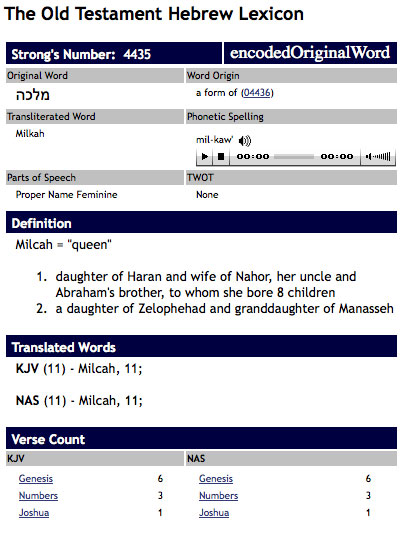
Queen of Milk, Strong’s #4435. Milkah bore her uncle eight children, because that was the close relationship you had with your uncle in those days. At SearchGodsWord.com you can hear the pronunciation of the both ancient Hebrew and Greek as part of definitions which are ordered according to Strong’s Concordance.
In the Bible the phrase “a land flowing with milk and honey” is a common refrain, painting a picture of future happiness. As you can see to the right, in Biblical times giving eight children to your uncle—which describes the close relationship women have historically had with their “uncles”—can make you queen, which is what “Milkah” means, a word that harbors “milk” at its root. Milkah is queen because she can nourish future generations. She is a carrier of survival. In Chinese, one’s father’s mother is called 奶奶 or literally “milk milk” because she too is acknowledged for nourishing future generations. This name is considered an honor. In Chinese, “wife” is the also-doubled 太太, which literally means “extremely extremely” or “too too.” What would have been doubly extreme on a new wife before birth control?
Tits. When I had my first child, my relatively small breasts were like silicone implants gone awry. I had to use bags of frozen peas on them in order to decrease the pain of their sudden enormity. In Chinese “tits” is 咪咪 or “mi mi,” which is also how you call a cat. Men are constantly conflating female mammals because they can but not because it’s correct. Reflecting how consistent English and Chinese mirror each other, could the two “O’s” of “too” also represent breasts? Certainly the two “O’s” of the infamous restaurant “Hooter’s” do. They are alleged to represent owl’s eyes, but of course this is blatant euphemism because the restaurant is all about sex with food thrown in as a secondary consideration. The marketers of Hooter’s capitalized on something many have missed: Eyes and breasts are both targets: a circle with a dot. Everyone is drawn to targets. The phrase “She’s making sheep eyes at me,” suggests that wide, unblinking eyes are attractive to men as well, or perhaps the attraction is to anything with a vagina. The sex researcher Alfred Kinsey wrote in the Kinsey Report that “that 17 percent of farm boys have intercourse with animals.” (My husband jokes that the other 83% are liars.)
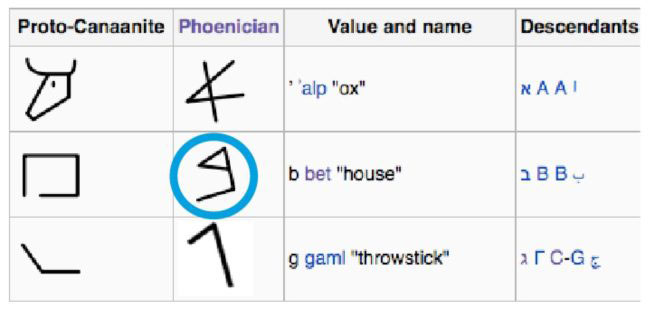
The most poorly drawn house in the world. A Wikipedia chart showing the roots of the first three letters of our alphabet, with the letter “B” delineated as “house,” though the Phoenician character (circled in blue) looks more like a lowercase “g,” a backwards “e,” or an angular “9.” This shape also resembles arms in a breast-feeding pose and a combination B/V character, which is the sound this shape represented.
Experts claim “B” comes from a symbol for “house,” but only in the same way that “bathroom” is the name for the place where you poop: “House” is a euphemism for “female mammals” because if you did not keep your female mammals—your “B/V’s,” if you will—locked up, someone would steal them and attempt to impregnate them, based on all evidence.
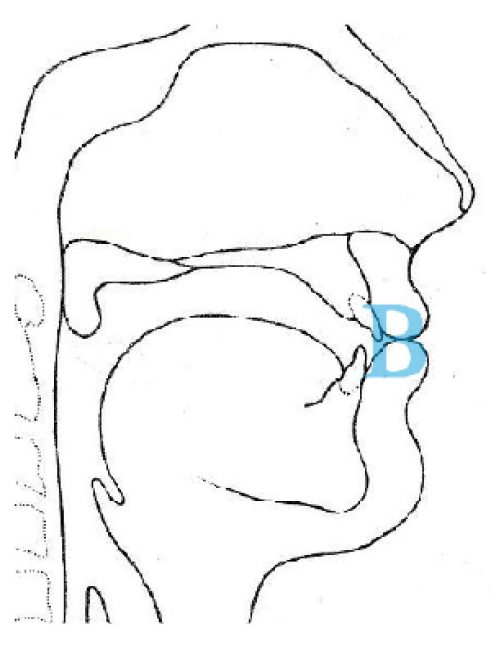
B: the picture of pronunciation. (I have added the blue “B” to illustrate.) “The following picture shows the pronunciation of [p] or [b] (bilabial plosive. If voiceless or voiced can not be told from a picture). Again, the lips are closed, but the velum is risen, so no air is escaping.” www.frufrusphonoweb/eng—chapters/consonants/manners-of-articulation/Stops
Our “B” sound came from the bubble that arises when one is bloated from bread or beast or bodacious tatas. The second sound of the alphabet is the noise one makes when one has been fed. BAA. BEH. BUH. The phoneme of our letter “B” is the noise you make when you burp or belch: a bilabial plosive, meaning that the sound explodes out of two lips. You don’t always know a burp is coming, which is why your lips are closed, and certainly someone new to the world, such as a baby, would be more likely to be surprised by an uprush of air from the stomach. A burp says that you’ve been fed. A burp says you’re no longer in pain. And no wonder you’re happy: no pain, you’ve been fed. Next is bed.
Both “B” and “V” signify for “female,” which then signifies for many euphemisms. “B” is balcony, “V” is valley. “B” is in the high rent district of the alphabet, “V” sits low (at the bad end of the alphabet where all the unknowns are: x, y, and z). “B” is on the top of a woman’s body, “V” is not. Try this: hold two fingers up to a woman as if giving the peace or victory sign and ask her what letter that represents; she’ll probably say “V.” However, if you ask her what body part it reminds her of, she might slap you (especially if you put your tongue in the middle; a tongue in the middle of two spread fingers instantly turns those fingers into a vagina). No coincidence that most words related to “vaults,” “vacuums,” and “caves” have “V” in them. In fact “vac” and “cav” are palindromes that both reference cavities and vacuities, which is what the vagina is. In Latin, “vagina” means “sheath,” for a presumed sword, which of course is the penis: another example in which male-derived language implies that women’s vaginas exist to be filled by men. Sheaths exist to cover swords, but swords do not exist to fill sheaths. In the same way that a “cat and mouse game” is only a game for the cat, language fools us by calling, for instance, a life or death experience for the mouse, a “game.” A game animal shares similar sentiments, no doubt. The writers of language dictate our perception of the world by the very concepts they used to describe everything, but their need to disguise the reality that sex drives men results in language that is both coded and a form of propaganda.
All writing is a kind of cryptogram, but the most common repeated symbol in written language is milk and mothers. This symbol usually comes in twos because the word for “milk” and “mother” emulates breasts (and occasionally a pregnant woman’s body). Double characters or double sounds in words can signify aspects of bilateral symmetry. We are all bilaterally symmetrical, which means we are composed of two halves that match. All animals, excluding radian sea life, are bilaterally symmetrical. For mammals who stand upright, large mammaries (breasts) are the most obvious difference between females and males. On human females, the mammaries are prominently placed and reduced in number (from other mammals) to one per lateral side, consistent with our other sense organs and appendages.
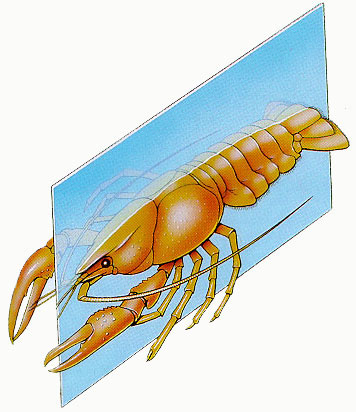
An example of bilateral symmetry. All mammals and most animals are bilaterally symmetrical, meaning that each half of an entity is a mirror-image of the other half, and that a theoretical plane down the middle separates the two halves.(Illustration: www.uic.edu/classes/bios/bios100/labs/bilateral.jpg.)
The dominant two-ness of bilateral symmetry can be seen in words related to milk (from two breasts) and sight (due to two eyes) because breasts and eyes were characteristics that were important to early man’s survival. Even the word “testes” signifies for two testicles, and we know they are important because we testify on them. They are a test of a male’s ability to procreate. Double characters found in scripts can function in decoding our language much as the “E,” the most common letter used in the English language, does in decoding cryptograms. That “E,” and especially the “silent E” is an eye watching over us all.
Logographic languages like Chinese and Egyptian demonstrate this breast/character relationship using a double symbol, but when we get to Hebrew, it’s a different situation. The second position in the Hebrew alphabet has the sound value of both /b/ and /v/, but the character itself looks like a 2: ב. Females are number two after the alpha male (other males are competitors). The second character of the Hebrew alphabet signifies for “female mammal” due to the fact that the character is pronounced /v/ when it is represented as above, but it has the sound value of /b/ when a dot (known as a “dagesh”) is put in the middle: בּ. That dot is a nipple. This character represents the two salient aspects of the female mammal: breasts and vagina. So this “2”-looking character demonstrates female mammals in a much more coded way than simple bilateral symmetry. One has to know the system in order to break the code: sometimes females are represented by a doubled “breast-like” symbol, sometimes they are represented by a breast/vagina relationship, sometimes by two “T’s,” sometimes by one “V,” and then of course there are flowers, and cherries and peaches, ad nauseum. The difference in how Hebrew depicts the coded concept of “female” versus Chinese or Ancient Egyptian demonstrates why decoding written language is so difficult: It takes a survey of all languages to see that there is a consistent over-representation of female mammals in written scripts. This is logical because civilization cannot continue without an abundance of pregnant females.
On left: In Hebrew, Bet stands for the “B” sound and Vet stands for the “V” sound, however, they are considered one character, both of which resemble the numeral “2.” That dagesh (dot) in Bet sure makes Bet seem like a breast and Vet seem like a vagina.
On right: The number two rotated 90° and flipped horizontally, Vet in the same orientation, and lowercase “u” side-by-side in order to show their resemblance to one another: all cul de sacs or uteruses.
The Hebrew character which comes second in the Hebrew alphabet, bet/vet, clearly demonstrates that early humans associated the sound of the second character with both the sound of our current letter “B” (still found at the beginning of the alphabet) and the sound of the letter “V” (now relegated to the end). Learning Spanish, I always wondered, what’s the relationship between “B” and “V”? When you see “vaca,” which is “cow,” you pronounce it “baca.” (In Hebrew this B/V switch is exactly the opposite—Abraham is pronounced Ahv–rrrrra-hum.) Looking at a “V” but making the sound for “B” just didn’t make sense to me. It seemed odd that the teacher didn’t explain this, like of course “B” and “V” always go together. I thought it was a B/V conspiracy: that everyone was pretending the letter “B” sounded like “V” when they don’t sound anything remotely alike. You don’t form them the same way. “Buh” takes both lips. “Vuh” takes the lower lips and the top teeth. Just making the sound vuh seems vulgar, as in “va va va voom.” We don’t know what “va va va voom” means, but it sounds racy (I can’t even show you Google’s image results on a Moderate Safe Search).
If this all seems too incredible, remember our alphabet started as graffiti—what does graffiti normally concern itself with? The precursors to our “A, B, Cs” were scratched on stones in the Sinai desert by men living on the outskirts of society who revered a cow-goddess. Why? Because they didn’t ever see women. The women were all imprisoned in harems or nunneries, in homes as daughters and wives. In Chinese, a character for “beautiful” is literally “big sheep”: 美 . And “cow pussy” 牛屄 is “awesome.” A more positive term than anything used for a women’s vagina, which is typically a curse. Miners and soldiers—who probably cared more about sex and eating than they did about progeny—were the unknown originators of the alphabet; these men carved pictures of things that were important to them, just as the Egyptians had for 1,000 years already at this point. Being in outposts like Serabit el-Khadim, where there was a turquoise mine, and Wadi el-Hol, which was midway along a desert road between Thebes and Abydos, these men were not controlled by the boundaries of civilization, so their depictions were cruder, fewer, and more to the point. They didn’t have to use someone else’s “stinking hieroglyphs” to make sense. They could make their own “talking” pictures. Once the idea of pictoralizing sound was introduced to society, anyone who could make a symbol that had buy-in with an audience as signifying for a recognizable object would succeed in communicating. This is why the shape of “V” has meant “female” for circa 6,400 years, based upon Denise Schmandt-Besserat’s token data. This shape means “fun” to men, and has for a long time. Because domesticating animals requires keeping track of the animals’ gender, it isn’t surprising that the system that arose utilizes symbolic depictions of genitals of domesticated animals. An actual picture of a vagina meant “woman, female” in Sumerian circa 4,300 years ago, according to the Pennsylvania Sumerian Dictionary.

In Ancient Egypt, there are allegedly two loaves of bread in the word for “milk.” This “loaf of bread” is the feminine ending for every thing female, even sow, an animal not known to have an association with bread, but known to have teats. It seems quite evident that this “Letter D rotated 90° ccw” is really a representation of a breast. Below is a selection from Sir Alan Gardiner’s Egyptian Grammar (male on left, female on right, note that the /t/ sound, rotated “D” representation is only on the right, which is the female side):
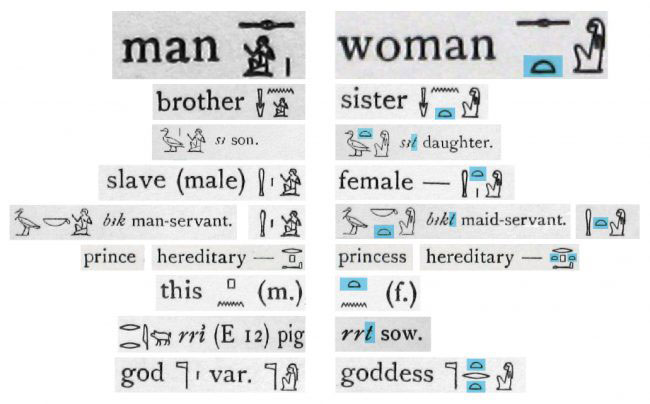
The “loaf” shape (highlighted in blue above) which codes for the /t/ sound is shown only on the right side which denotes “female” and, notably, not on the left, which denotes “male.” The sole difference between left and right columns, besides the determinative, is this /t/ sound, represented as a half-circle or “loaf” shape. Note that even a sow gets a “loaf.” Or is it a teat? A goddess gets two “loaves” because she provides bounty to mankind, as does a hereditary princess.
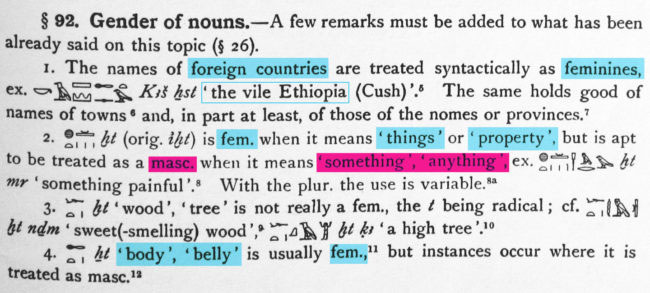
Foreign countries are feminine (feminine concepts are highlighted in blue) because the Egyptians would have wanted to dominate them (if this isn’t clear, the word “vile” should make it so). Things or property are feminine because you own them (evident bias that carries antiquated logic). Masculine gender (masculine concepts are highlighted in red) is used for “something” or “anything.” “Tree” is feminine (despite Gardiner’s bizarre rationalization) because it provides sustenance. Finally, feminine bellies could be forced to replicate.
As the feminine ending, this ![]() character is often the only difference, besides the determinative, between a male and female occupation (such as man/woman, son/daughter, male slave/female slave, etc.). Perceiving this as a loaf of bread is a form of denial.
character is often the only difference, besides the determinative, between a male and female occupation (such as man/woman, son/daughter, male slave/female slave, etc.). Perceiving this as a loaf of bread is a form of denial.

Bread or breast? Sir Alan Gardiner, in his 1927 Egyptian Grammar, calls this /t/ sound a “loaf.” The word “loaf” connotes a shape. By analyzing the words in which this character is found, it would appear this half circle has more to do with the perception of female sustenance than it does with bakers.
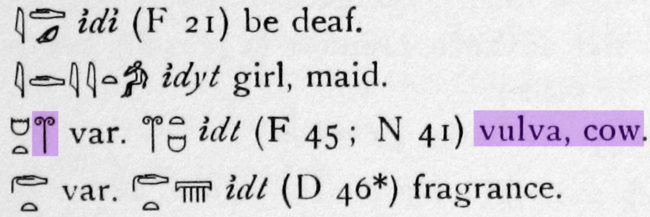
The root of our word “idiot”? In Greek, “idiotes” meant “private person.” The purple highlighted Fallopian-tube symbol means “bicornuate of heifer” and seems to indicate the same structure in women. (Egyptian Grammar, page 556.)
The hieroglyphic definitions above are from Gardiner. They demonstrate that the Egyptians were not politically correct. Note how close these words are to our word “idiot.” The Greeks defined “idiotes” (Strong #2399) as a “peculiar” or “private person,” which is what someone would be who is sequestered and uneducated. In a culture where women are sheltered, the average man might rarely see one—and then, only a relative—so the enclosure where women lived would stand in for them, a kind of synecdoche where a whole stands in for a part, or, as in this case, the house stands in for the woman. No wonder linguists think “B” stood for “house” because women and houses were synonymous.
Sir Alan Gardiner’s Egyptian Grammar, the Bible of the hieroglyphs, was written in 1927, and it is still considered the definitive reference on Egyptian writing. Gardiner was meticulous, but the character he refers to as “loaf” (see above) is another euphemism. The word “loaf” connotes a shape, a measure word, not so much an entity. This half-circle is very similar to our “D” letterform, just rotated 90° counterclockwise. The sounds of “D” and “T” are the same, except for the voicing of the larynx. Words like “udder” and “utter” demonstrate this closeness: sonorously alike, only superb enunciation distinguishes them, but pictorially the “D” signifies for “teat” in “udder” (its shape can hold milk) and the “T” signifies for “tongue” in “utter” (its shape sticks out). Lips to breasts, milk to tongue. The relationship between milk and tongue seems pretty clear: another linguistic figure/ground relationship.
The /t/ sound, being the Egyptians’ feminine ending, appears to actually represent breasts and not bread. The Ancient Egyptian character that represented “milk” in Ancient Egypt is literally “to make TT,” which sounds like “to make titty,” which sounds a lot like “milk” to me. Considering that “nefer” meant “beautiful” in ancient Egyptian, this perspective gives a new meaning to the name “Nefertiti.” Perhaps beautiful tits was in high regard then as it is now, but it is not a regard that lasts.
“T” and “A” are two letters that we recognize as parts of female anatomy, just like “B” and “V.” The musical A Chorus Line has a song devoted to tits and ass. In fact, we might even see “TT” as a substitute for “B” and “A” as a substitute for “V.” Both substitutions have a similar symmetry.

That double-“T” sound doesn’t just stand for milk. Here the “loaf/breast shape” is used to define similarity, because what is more similar than a woman’s breast and its companion?
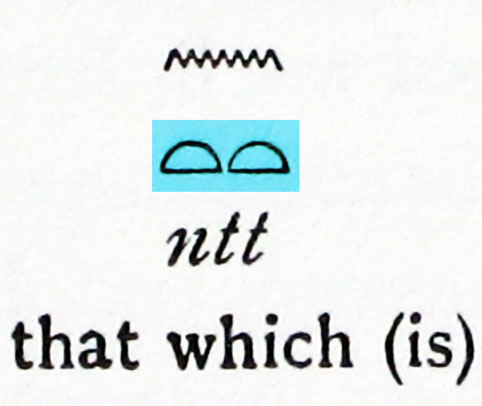 “That which” is an equivalency. This hieroglyph shows two items which everyone knows are equal: breasts. The wavy line is water and represents the “N” sound.
“That which” is an equivalency. This hieroglyph shows two items which everyone knows are equal: breasts. The wavy line is water and represents the “N” sound.
A simple way to show two of something would be to draw it twice. The two-humped symbol of the Egyptians which stood for the double “T” sound is an example of such repetition. How better able to impart the sense of something repeating than to look toward nature—and the twins of sustenance, female breasts—as the easy illustration? The double “T” representation was the way the Egyptians showed “female,” as well as “resemblance” and “equality” (one breast looks like the other, and they always come together).
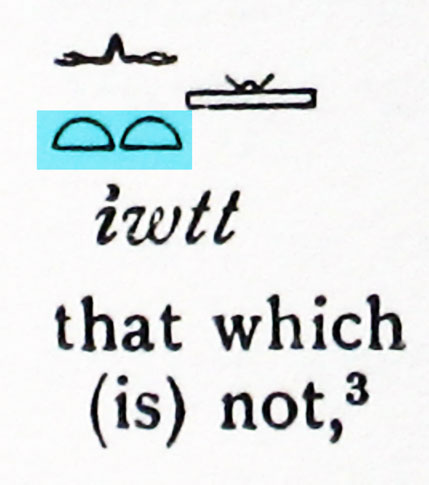
“Not” is represented by the arms. The tablet stands for “writing,” an abstraction that is less concrete than water.
A commodity as important as milk doesn’t just show up in only one form in language. A personage as important as female—the container milk comes in—doesn’t just show up as one depiction either. Once that ubiquitous symbol of milk became the recognized sign of sustenance, it soon becomes the basis, the root of meaning. It turns out that metaphor is more than a linguistic conceit. George Lakoff, a student of Chomsky’s who founded Cognitive Linguistics, writes: “Our ordinary conceptual system…is fundamentally metaphorical in nature….But [it] is not something we are normally aware of.” It is the use of metaphor that allows us to have abstract thought. Lakoff uses the examples of personification: “We need some new blood in the organization,” where blood stands in for people, and “There are a lot of good heads in the university,” where heads stands in for intelligent individuals. Lakoff calls this “metonymy” whereas “traditional rhetoricians have called [this] synecdoche…..In the case of the metonymy… there are many parts that can stand for the whole. Which part we pick out determines which aspect of the whole we are focusing on.” In the case of women and the alphabet, the “B” shape focuses on breasts and milk, the “V” shape focuses on the vagina and reproduction. Egyptians used our double “D” shape and double /t/ sound to refer to sustenance and females. All of these shapes and sounds metaphorically refer to the whole of female mammals because female mammals are the underpinning of written language due to the fact that they are the world’s first automation: you impregnate them, they produce.
“Why the alphabet is breasts, vaginas, and tools,” I told my husband, and he said, “Aren’t they all just tools?”
Those tools—or whatever you want to call them—still matter to us today because they were the means to survival. What drove early humans appears to be consistent across all cultures. We exist because primates figured out strategies that enabled them to further the species. One of these strategies was procuring milk, something only females have, which could explain why this /t/ sound was the feminine ending. Baking bread wasn’t even specifically a woman’s job in Ancient Egypt. According to Mistress of House, Mistress of Heaven, Women in Ancient Egypt,” only “one industrial craft…seems to have been exclusively [women’s], at least through the end of the Middle Kingdom. This is the manufacture of linen textiles….[Women] also bake bread, an activity they sometimes share with men….these people were usually paid in measures of grain; their town sites have yielded numerous bread molds.” Numerous bread molds, yet only the D-shaped hieroglyph is thought to resemble bread. Seems suspicious.
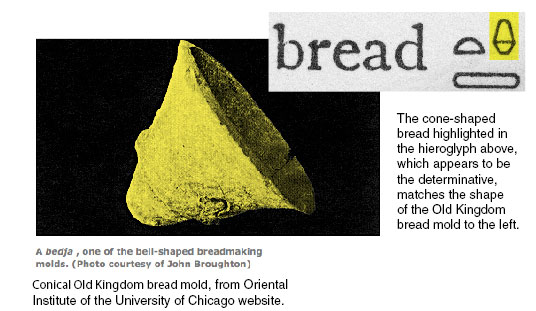
The determinative for bread (yellow in the hieroglyph below) appears to be cone shaped, as were many of the Egyptian bread molds. If there was a consistent shape for bread, it would have been conical, not a half-circle. This bread determinative matches the shape that would have come out of the Old Kingdom bread mold.
Tata, titi: Food is food, no matter what form it takes, bread or breast. Sustenance cannot be underestimated, but one form clearly predated the other. According to Marilyn Yalom of Stanford University in her book History of the Breast, women have long been viewed as sustenance. “With their breasts represented like udders or fruits on a tree, women have traditionally been conflated with the animal and plant kingdoms and isolated from the “thinking” or “spiritual” realm reserved for men. Because women have breasts and the potential to provide milk for their young, females have been seen as closer to Nature than their male counterparts—indeed as the very personification of Nature—and assigned major responsibility for all the food that humans ingest on a daily basis.”
Two depictions of Isis: first is human Isis nursing Horus. This pose is considered by many to be the prototype for Mary nursing Jesus. “Because of her fierce devotion to and protection of her son, Isis came to be regarded in Late Dynastic Egypt as the paradigm of the devoted mother…often invoked for the protection of children….From an early period, Isis’s suckling of Horus symbolized her pivotal role in the transmission of divine kingship. Each new king who succeeded to the throne was considered to be the ‘living Horus,’ the incarnation of the son of Isis and Osiris. Isis was thus the symbolic mother of each king and one of his links to the divine world.”
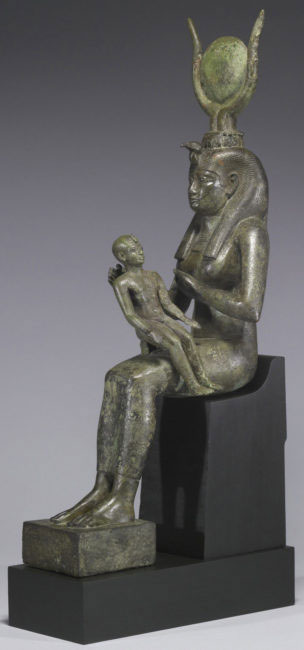
Second is a depiction of Isis, as a sycamore tree, nursing Thutmose IV, from the 18th dynasty. The tree lifts its breast in a gesture common to all time, demonstrating the willingness to nourish. Writes Yalom in History of the Breast, “In the lands that have become present-day Israel, almost all the clay idols from the biblical period are females, and many of them lift up their breasts for emphasis. This is particularly true of the pillar figures from the eighth to the sixth centuries B.C.E. known as “Astarte” figurines, after the Phoenician goddess of love and fertility. This dea nutrix (nourishing deity) has been described as a kind of tree with breasts.”
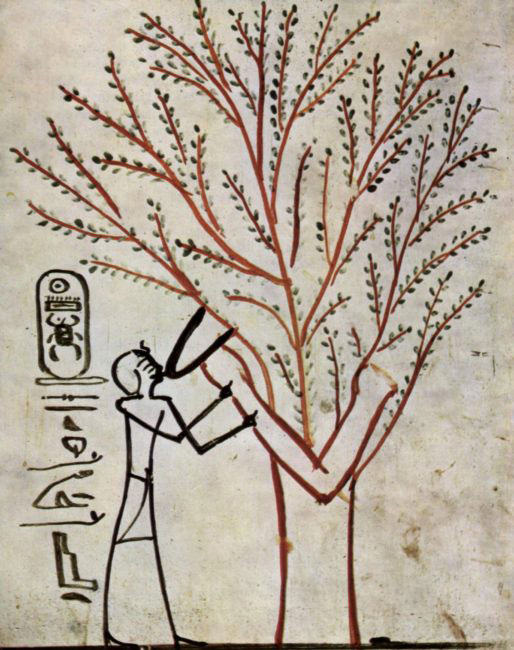
Isis as a lactating tree. Thutmose IV is nursed by the goddess Isis posing as Mistress of the Sycamore. Queens of Egypt, Joyce Tyldeseley, page 157.
Breasts separated from the body was not an oddity to early man. “At certain ancient sites, breast fetishes have been found isolated from the rest of a female body. Outside the French cave sanctuary at Le Colombel, Pech Merle, for example, a stalactite from around 15,000 B.C.E., resembling a female breast down to the nipple, was circled with dots of red ocher. Almost ten thousand years later, at Çatal Hüyük, in south-central Turkey, rows of clay breasts were plastered onto the walls of a holy shrine, with animal teeth, tusks, and beaks inserted where the nipples should be (History of the Breast).
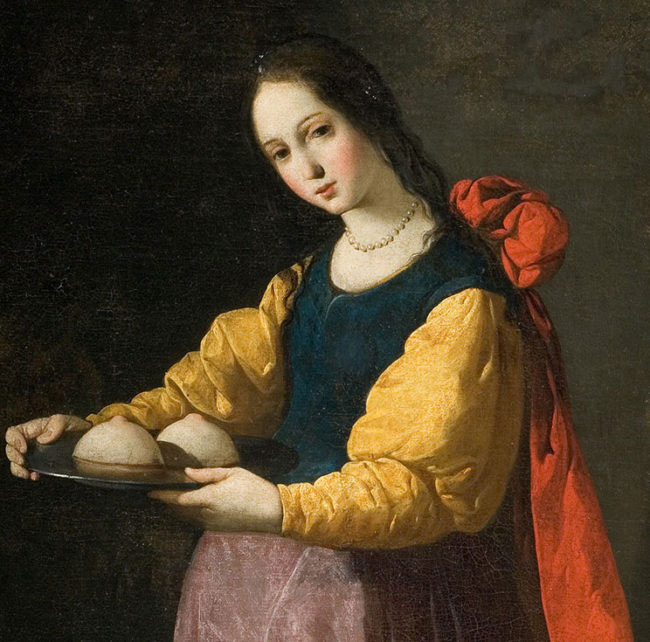
Here you can see Saint Agatha as depicted in the 17th century by Francisco de Zurbarán, her detached breasts looking similar to the Egyptians’ double-T character.

Hathor, one attractive cow-woman. Ptolemaic Era (circa 300 B.C.). Both Hathor and Isis sport the horns and the solar disk of divinity, accoutrements which signify their ability to bequeath kingship. (Mistress of House, Mistress of Heaven, page 123.)
Why would it surprise us that breasts would fascinate early man when they clearly fascinate the present day populace? Bosoms are everywhere: on billboards, magazines, and computer screens. And we have been bred to desire it. “Bread” and “breast” both have etymological roots in similar ideas: the Oxford English Dictionary (OED) says bread may come from “piece, bit” and breast from “‘buds’ or ‘sprouts.’” “Bit” and “bud” sound similar and share smallness of size. They are also a piece of the whole. A “piece” is a term that women are often called disparagingly (also “bit-ch”), and this word is significant in that a piece can only ever be part of something else. The dissociation of women with their external organs is in keeping with early man’s (and frankly, some current men’s) ability to compartmentalize the aspects of nature with which early man was conflicted. Women had enormous power in their ability to nurture, but if breasts were separated from women, then any entity with breasts would also have that nurturing power, even men. Even a tree. Like prehistoric Mr. Potatoheads, Egyptian gods had both animal and human characteristics that were essentially stuck on, as you can see with the Sphinx, which had a lion body, wings, human head and often a female bust. Hathor, the bovine goddess, was depicted as a mixture of cow and human parts (which always included mammaries).
Confusion about the role of genetics, and the lack of prenatal care (which no doubt engendered fetal abnormalities) could have increased the idea that humans and animals together could create offspring. A chimera, which is a creature comprised of a mixture of animals, was a tangible way to show that attributes, such as horns or breasts, was the province of the gods’ wills and a show of power.
The bottom line: everyone wanted breasts. Here are the twin Hapis—Hapi is the Nile God usually depicted as a pair. Both sport at least one female mammary. “The female breasts on the chest of the male river god Hapi symbolize his ability to overflow the banks of the Nile with the water needed for crops” (History of the Breast). Easy Ancient Egyptian propaganda, if you want to show how well you provide for people, chisel breasts on the latest carving, whether or not anyone had ever seen functioning mammae on a man, or a tree nursing a human. The message was paramount and of more importance than realism. Breasts on male twins was the best of all possible worlds, even if it wasn’t possible.
Hapis with breasts. The male Nile god was often depicted as a pair of twins with mammaries and large stomachs which symbolized the inundation of the Nile. Flooding was desired for the fertile soil the waters left behind.
It doesn’t surprise me that Egyptologists see this shape as bread rather than as a breast, because our culture is still unable to recognize that we are animals driven by genes, and our genes dictate that we, on the whole, must procreate. This loaf shape ultimately represents a sex organ, one that delivers manna from heaven. Considering that the average life expectancy for a women was “probably in the mid- to low twenties” and for men it was “at least twenty-five years,” (The Oxford History of Ancient Egypt, Ian Shaw, page 435).
Egyptians were teenagers with children. No wonder the hieroglyphs include 63 dissociated body parts. The Egyptians liked to compartmentalize. Chimeric individuals and interchangeable parts were natural for them because they were just figuring out genetics. Above you can see a detachable penis in the hieroglyph for “beget”—a Biblical word that means “producing children,” specifically by the father. This hieroglyph includes a helpless quail chick, an ejaculating phallus, and TWO LOAVES OF BREAD. Of course, there’s no vagina in sight, so the Egyptians were less clear on the role of the uterus.
The “woman is a tool” concept is rooted in our metaphors, our thinking, and our language. Based on this depiction of “beget” and Gardiner’s interpretation of the “T” sound, women’s participation in childbirth would appear to consist of baking—a bun in the oven. Maybe that’s all the truth the world could handle in 1927, but it’s the 21st century now. Let’s get real. It doesn’t take two loaves of bread to have children. Those double humps are female breasts and this perfect half-circle can be seen in both our uppercase “B” and “D.” Our alphabet reinforces the compartmentalization of humans.
Reducing someone to a body part implicitly denies that she is a person. That’s why recognizing women’s role in language is important because literate cultures have been bad-mouthing women for a very long time.
Footnotes:
- The Independent, Aug. 26, 2009. 英国《独立报》,2009年8月26日刊
- The Riot Act in L.A. circa 1983 had bit that included the woman’s name “Lotta Balcony.” 1983年左右时在洛杉矶出现的喜剧团体The Riot Act【译者注:该喜剧团体的名称的来由是同名的英国法律暴动法】,会将女性称为“Lotta Balcony(很多的阳台)”。【译者注:此处双关点为阳台与乳房一样突出并且都以“B”开头】
- Mother Tongue, page 227.《母语》一书第227页
- The Language Instinct, © 1994, page 238.《语言直觉》,出版于1994年,第238页
- The Blank Slate: The Modern Denial of Human Nature, © 2002, page 55.《空白页——现代人对人性的否认》,出版于2002年,第55页
- The Alphabet, A Key to the History of Mankind, David Diringer, D. Litt, © 1948, page 195. 《字母表——解读人类史的关键》,文学博士大卫·迪林格出版于1948年,第195页
- Guns, Germs, and Steel, © 1997, page 255. 《枪炮,细菌,钢铁》,出版于1997年,第255页
- Wikipedia: Strong’s Concordance. 维基百科:《施特朗圣经汇编》
- “HEBREW” Concise Oxford Companion to the English Language. Ed. Tom McArthur. Oxford University Press, 1998. Oxford Reference Online. Oxford University Press. 《简明牛津英语指南》,艾德. 汤姆 麦克阿瑟著,牛津大学出版社出版于1998年;牛津在线大辞书;牛津大学出版社,词条“HEBREW”
- http://cdli.ucla.edu/pubs/cdlj/2009/cdlj2009_004.html.见网页http://cdli.ucla.edu/pubs/cdlj/2009/cdlj2009_004.html
- The Language Instinct, Pinker, page 167. 《语言直觉》一书第167页,平克著
- The Language Instinct, page 175. 《语言直觉》一书第175页
- The Language Instinct, page 248. 《语言直觉》一书第248页
- Egyptian Grammar, Gardiner, page 627. 《古埃及语法书》一书第627页,加德纳著
- Harem years: the memoirs of an Egyptian feminist (1879-1924) / by Huda Shaarawi ; translated, edited and introduced by Margot Badran, © 1986. 《妻妾成群的日子——一位埃及女权主义者的回忆录(1879-1924)》,胡达·沙入薇著;1986年由玛戈·巴德兰翻译编辑并引入。
- Wolfgang G. Müller, Olga Fischer, Friedrich—Schiller—Universität Jena. 《从记号到手语的使用:语言的形象性与文学3》,席勒·耶拿大学沃尔夫冈G.穆勒,奥尔加·费舍尔著
- Metaphors We Live By, George Lakoff and Mark Johnson, © 1980, 2003, page 3. 《我们赖以生存的隐喻》,乔治拉考夫及马克·约翰逊著于1980年,编辑于2003年,第3页
- ibid, page 36. 同上,第36页
- History of the Breast, Marilyn Yalom, page 16. 《乳房的历史》,玛丽莲·亚隆著,第16页
- Mistress of House, Mistress of Heaven, page 127. 《房子的女主人——天堂的情妇》一书第127页
- History of the Breast, Marilyn Yalom, pp. 10-11. 《乳房的历史》,玛丽莲·亚隆著,第10至11页
- Buffie Johnson, Lady of the Beasts: Ancient Images of the Goddess and Her Sacred Animals, p. 44. (History of the Breast). 《野兽中的女人:女神以及圣兽的古代影像》布菲·约翰逊著,第44页(《乳房的历史》)
- James Mellaart, Çatal Hüyük, figs. 25-28; Adele Getty, Goddess: Mother of Living Nature, pp. 11-12 (History of the Breast). 《休于古城》詹姆斯·梅拉特著,例证取自25-28页;《女神:大自然的母亲》,阿黛尔·盖提著,第11至12页(《乳房的历史》)【译者注:书二中的例证摘自书一】
- History of the Breast, Marilyn Yalom, page 13. 《乳房的历史》,玛丽莲·亚隆著,第13页
- The Art of Ancient Egypt, David Sandison, © 1997, page 31. 《古埃及的艺术》,大卫·桑迪森著于1997年,第31页
- Hieroglyphics, the Writings of Ancient Egypt , page 185. 《象形文字——古埃及的文字》一书第185页
- The Oxford History of Ancient Egypt, Ian Shaw, page 435. 《牛津古埃及历史》,伊恩·肖著,第435页
- Mother Tongue, Bill Bryson, page 222. 《母语》,比尔·布赖森著,第222页
- The Blank Slate, Steven Pinker, page 120. 《空白页——现代人对人性的否认》史蒂芬·平克著,第120页
